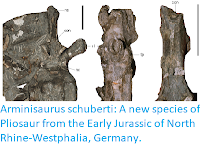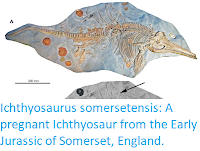The Sauropterygians were a diverse group of Mesozoic Marine Reptiles which included groups such as the Nothosaurs and Plesiosaurs, which flourished in the Triassic, but largely died out at the end of that period, with only the Plesiosaurs surviving into the later Mesozoic. The Pachypleurosaurs were one of the Triassic Sauropterygian groups, and were small (less than a metre) animals superficially resembling aquatic Lizards (though Sauropterygians are less closely related to Lizards than are Crocodiles, Turtles, or Dinosaurs), known from Triassic deposits in Europe and southwest China.
In a paper published in the journal Acta Palaeontologica Polonica on 26 April 2019, Khaing Khaing San of the Geology Department at Yadanabon University, Nicholas Fraser and Davide Foffa of the School of GeoSciences at the University of Edinburgh, Olivier Rieppel of the Center of Integrative Research at the Field Museum in Chicago, and Stephen Brusatte, also of the School of GeoSciences at the University of Edinburgh, describe the presence of Pachypleurosaurs in the Nwabangyi Dolomite Formation of northern Shan State in Myanmar.
The specimens were found within the Lashio Basin of northern Shan State, a sequence of sedimentary rocks which date from the Middle Devonian to the Jurassic. The Nwabangyi Dolomite Formation is a sequence of mudstones, wackestones, and dolomitic limestones considered to be Late Permian to Middle Triassic in age. The fossils come from an iron-rich limestone layer within this, which has also produced numerous Fish bones and scales.
The first specimen described comprises partial skull, much of the neck and pectoral girdles, and a substantial portion of the trunk. It is not well preserved, preventing a detailed analysis of much of the skeleton, but the retroarticular process is free of the skull, a typical Pachypleurosaur feature, and the humerus strongly curved, another feature common in Pachypleurosaurs.
The second specimen comprises much of the skeleton, with a short-snouted skull and overall body proportions, that are typical for Pachypleurosaurs, and homodont dentition comprising numerous small, peg-like teeth.
Neither of the skeletons is well enough preserved to be useful in a phylogenetic analysis (family tree based upon comparison of the similarity between features in a group of animals), leading Khaing Khaing San et al. to avoif describing them as a new species. Nevertheless, the specimens are useful, proving that this group did reach Myanmar, and confirming the Triassic age of the host rock, something which until had only been inferred.
See also...
The first specimen described comprises partial skull, much of the neck and pectoral girdles, and a substantial portion of the trunk. It is not well preserved, preventing a detailed analysis of much of the skeleton, but the retroarticular process is free of the skull, a typical Pachypleurosaur feature, and the humerus strongly curved, another feature common in Pachypleurosaurs.
Unidentified Pachypleurosaur from the Triassic of Myanmar, in dorsal view. Much of the neck, pectoral girdles, and trunk are preserved, along with part of the skull and forelimbs. The pelvis, hindlimbs, and tail are not preserved. Photograph (A₁) and explanatory drawing (A₂). Khaing Khaing San et al. (2019).
The second specimen comprises much of the skeleton, with a short-snouted skull and overall body proportions, that are typical for Pachypleurosaurs, and homodont dentition comprising numerous small, peg-like teeth.
Unidentified Pachypleurosaur from the Triassic of Myanmar, in dorsal view. Most of the skeleton is preserved, except for the tail. Photograph (A₁) and explanatory drawing (A₂). Khaing Khaing San et al. (2019).
Neither of the skeletons is well enough preserved to be useful in a phylogenetic analysis (family tree based upon comparison of the similarity between features in a group of animals), leading Khaing Khaing San et al. to avoif describing them as a new species. Nevertheless, the specimens are useful, proving that this group did reach Myanmar, and confirming the Triassic age of the host rock, something which until had only been inferred.
See also...
Follow Sciency Thoughts on Facebook.








